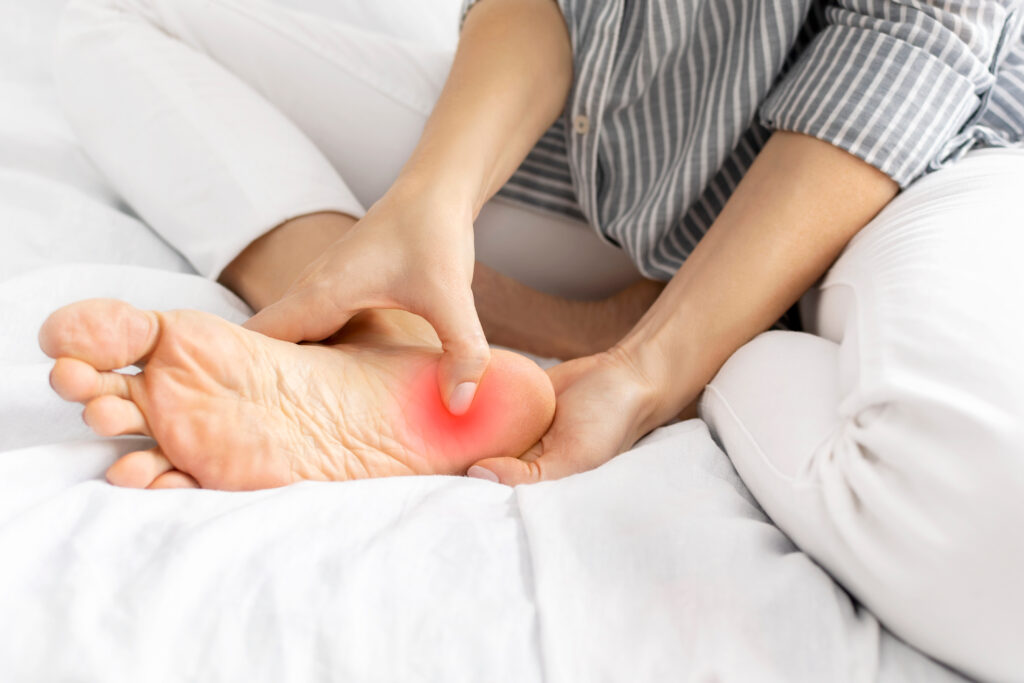Tips for Managing Your Plantar Fasciitis
 Plantar fasciitis is one of the most common causes of heel pain, especially among older adults. The condition occurs when the plantar fascia, a thick band of tissue along the bottom of the foot, becomes inflamed due to stress and overuse. For seniors, natural changes in foot structure—such as reduced cushioning, weaker arches, and decreased flexibility—can make plantar fasciitis more painful and persistent. However, with the right approach, it is possible to manage symptoms and maintain an active lifestyle. In this guide, we’ll explore practical tips, including proper footwear, stretching exercises, home remedies, and when to seek professional care.
Plantar fasciitis is one of the most common causes of heel pain, especially among older adults. The condition occurs when the plantar fascia, a thick band of tissue along the bottom of the foot, becomes inflamed due to stress and overuse. For seniors, natural changes in foot structure—such as reduced cushioning, weaker arches, and decreased flexibility—can make plantar fasciitis more painful and persistent. However, with the right approach, it is possible to manage symptoms and maintain an active lifestyle. In this guide, we’ll explore practical tips, including proper footwear, stretching exercises, home remedies, and when to seek professional care.
Supportive Footwear Matters
Wearing the right shoes is one of the most important steps in managing plantar fasciitis, especially for older adults. As we age, the natural padding on our feet thins, and the arches may weaken, making proper footwear essential for comfort and pain relief.
Key Features of Supportive Shoes
When selecting footwear, look for the following:
- Good Arch Support – Helps distribute weight evenly and reduces strain on the plantar fascia.
- Cushioned Insoles – Absorbs shock and minimizes impact on the heels.
- Firm Heel Counter – Provides stability and prevents excessive foot movement.
- A Wide Toe Box – Prevents crowding of the toes, reducing additional foot discomfort.
- Low, Supportive Heel – Avoids excessive strain on the arch and heel.
Shoes to Avoid
Certain types of footwear can make plantar fasciitis worse. It is best to avoid:
- Flip-flops and sandals without arch support.
- Worn-out sneakers with little cushioning.
- High heels or completely flat shoes that offer no support.
Gentle Stretching and Exercises
Regular stretching and strengthening exercises can help relieve plantar fasciitis pain by improving flexibility, reducing tension in the plantar fascia, and supporting the muscles in the feet and lower legs. It is important to focus on gentle, low-impact movements that do not strain the joints.
Stretching Exercises to Reduce Heel Pain
Calf Stretch
- Stand facing a wall and place both hands on it for support.
- Step one foot back, keeping it straight with the heel on the ground.
- Bend the front knee slightly and hold the stretch for 15 to 30 seconds.
Towel Stretch
- Sit with your legs extended in front of you.
- Loop a towel or resistance band around the ball of your foot.
- Gently pull the towel toward you, keeping your knee straight.
Plantar Fascia Stretch
- Sit in a chair and cross one foot over the opposite knee.
- Use your hand to pull back on the toes, stretching the arch of the foot.
- Hold for 15 to 30 seconds and repeat on the other foot.
Strengthening Exercises to Support Foot Health
Toe Curls with a Towel
- Place a towel on the floor and use your toes to scrunch it toward you.
- Repeat for 10 to 15 repetitions on each foot.
- This helps strengthen the small muscles in the foot that support the arch.
Rolling Massage
- Sit in a chair and roll a frozen water bottle, tennis ball, or massage ball under your foot.
- Apply gentle pressure and roll back and forth for one to two minutes per foot.
- This can help loosen tight fascia and reduce discomfort.
Heel Raises
- Stand near a chair or counter for support.
- Slowly rise onto your toes, lifting your heels off the ground.
- Lower back down and repeat 10 to 15 times.
The Role of Orthotics and Inserts
Orthotic inserts can play a crucial role in managing plantar fasciitis, especially for older adults who need extra foot support. These inserts help distribute pressure more evenly across the foot, reducing strain on the plantar fascia and providing cushioning for the heel. Over-the-counter arch supports can offer relief for mild to moderate cases, while custom orthotics, prescribed by a podiatrist, are designed to address specific foot structures and gait patterns. Wearing orthotic inserts in supportive shoes can improve alignment, enhance comfort, and prevent further irritation, making them an effective long-term solution for foot pain.
Understanding Plantar Fasciitis in Seniors
Plantar fasciitis is a common cause of heel pain, particularly in older adults. It occurs when the plantar fascia—a thick band of tissue that runs along the bottom of the foot—becomes inflamed due to stress and overuse. While plantar fasciitis can affect people of all ages, seniors are especially vulnerable due to natural changes in foot structure and function over time.
Why Is Plantar Fasciitis More Common in Older Adults?
- Loss of Natural Cushioning: The fat pads on the heels thin out, reducing shock absorption and increasing pressure on the plantar fascia.
- Decreased Flexibility: The ligaments and tendons in the feet can stiffen, making them less able to absorb impact.
- Weakened Arches: The arches of the feet may flatten with age, placing extra strain on the plantar fascia.
- Reduced Circulation: Slower blood flow to the feet can hinder the body’s ability to heal from inflammation and minor injuries.
Lifestyle Adjustments for Long-Term Relief
Making simple lifestyle adjustments can significantly reduce plantar fasciitis pain and prevent it from worsening. Maintaining a healthy weight helps minimize excess pressure on the feet, while avoiding prolonged standing or walking on hard surfaces can prevent further strain on the plantar fascia. Engaging in low-impact exercises like swimming or cycling keeps the feet active without adding stress, and wearing supportive shoes both indoors and outdoors provides continuous arch support. Additionally, incorporating daily stretching routines and taking regular breaks to rest and elevate the feet can aid in long-term pain management. By making these small changes, seniors can improve foot health, enhance mobility, and reduce discomfort in daily activities.
When to See a Podiatrist
While home remedies and lifestyle changes can help manage plantar fasciitis, persistent or worsening pain may require professional care. At Red Mountain Footcare, our experienced team understands the uniqueness that plantar fasciitis can present. We offer comprehensive services tailored to you, ensuring a plan that serves your unique needs. Call today to schedule an appointment.
